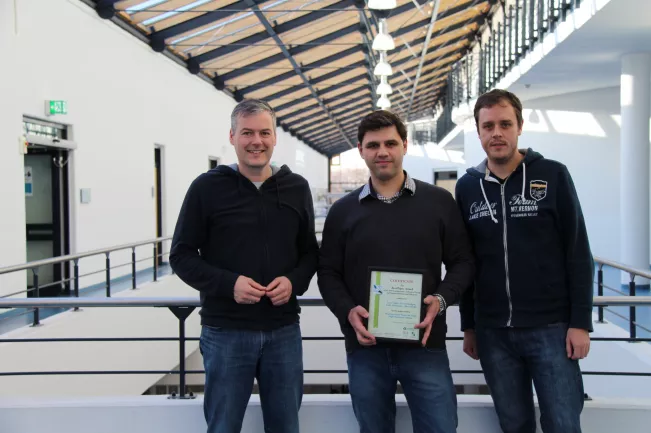Fachbereich Informatik
Best Paper Award for Anton Sigitov

Research associate Anton Sigitov and his project group (professor André Hinkenjann, David Scherfgen and professor Oliver Staadt from Rostock University) have received a Best Paper Award at the International Conference Virtual and Augmented Reality in Education (VARE´15) in Monterrey (Mexico).
Their paper "Adopting a Game Engine for Large, High-Resolution Displays" presents an extension for the Unity Game Engine that has been developped specifically for large high-resolution displays in an educational context. These screens become more and more affordable and will soon be standard equipment both in companies and in research organizations. Thus it is vital to provide IT students with skills in multi-display rendering and give them an opportunity to become familiar with the technology.
Abstract
The steadily decreasing prices of display technologies and computer graphics hardware contribute to the increasing popularity of multiple-display environments, like large, high-resolution displays. It is therefore necessary that educational organizations give the new generation of computer scientists an opportunity to become familiar with this kind of technology.
However, there is a lack of tools that allow for getting started easily. Existing frameworks and libraries that provide support for multi-display rendering are often complex in understanding, configuration and extension. This is critical especially in educational context where the time that students have for their projects is limited. These tools are also rather known and used in research communities only, thus providing less benefit for future non-scientists.
In this work we present an extension for the Unity game engine. The extension allows – with a small overhead – for implementation of applications that are apt to run on both single-display and multi-display systems. It takes care of the most common issues in the context of distributed and multi-display rendering like frame, camera and animation synchronization, thus reducing and simplifying the first steps into the topic.
In conjunction with Unity, which significantly simplifies the creation of different kinds of virtual environments, the extension affords students to build mock-up virtual reality applications for large, high-resolution displays, and to implement and evaluate new interaction techniques and metaphors and visualization concepts. Unity itself, in our experience, is very popular among computer graphics students and therefore familiar to most of them. It is also often employed in projects of both research institutions and commercial organizations; so learning it will provide students with qualification in high demand.
Links
Weiterführende Links